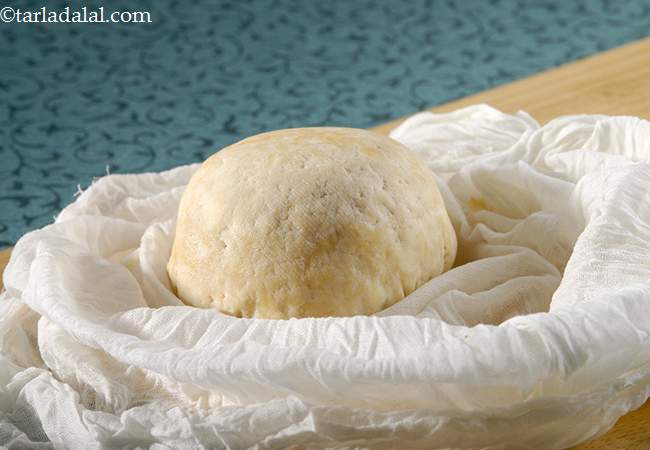Paneer and Spinach Soup serves 4, 200 ml per serving.
172 calories for 1 serving of Paneer and Spinach Soup, Cholesterol 3.8 mg, Carbohydrates 12.7g, Protein 8.4g, Fat 9.8g. Find how much fibre, iron, calcium, zinc, magnesium, phosphorus, sodium, potassium, folic acid is present in Paneer and Spinach Soup.
paneer and spinach soup recipe | Indian palak soup with paneer | healthy palak paneer soup | spinach cottage cheese soup |
paneer and spinach soup is a fragrant and nourishing Indian soup with soothing flavours. Learn how to make healthy spinach paneer soup.
Subtly flavoured this spinach cottage cheese soupis a wholesome fare that you will love to slurp up. Palak cooked and blended to a puree, thickened with moong dal and perfectly pepped up with onions, salt and pepper is a delight for the taste buds.
The protein-packed healthy palak paneer soup is a meal in a bowl! generous use of moong dal, paneer and spinach make it extremely nourishing and filling, while the onion and pepper bring in their soothing yet sharp flavours
Is Paneer and Spinach Soup healthy?
Yes, this is healthy. But restrictions apply to some.
Let's understand the Ingredients.
What's good.
1. Spinach (Palak): Spinach is one of the richest plant sources of Iron and it should be part of a healthy diet for everyone. Raw spinach is very rich in insoluble fibre, 25% having soluble fiber and 75% insoluble fiber. Spinach is good for the heart, diabetics and eyes. Read this on the 17 benefits of spinach and why you should eat it.
2. Yellow Moong Dal: The fibre (4.1 g in ¼ cup) present in yellow moong dal prevents the deposition of bad cholesterol (LDL) in the arteries which promotes a healthy heart in turn. Packed with nutrients like zinc (1.4 mg), protein (12.2 mg) and iron (1.95 mg), yellow moong dal helps to maintain the elasticity of your skin and help to keep it moist. Fiber, potassium and magnesium from yellow moong dal will work together to regulate blood pressure and soothe the nerves and is diabetic friendly. See here for details of 7 amazing benefits of yellow moong dal.
3. Onions (pyaz, kanda): Raw onions are a very valuable source of vitamin C – the immune building vitamin. Along with other phytonutrients from onions, it helps to build WBC (white blood cells) which serves as a line of defence against illness. Yes, it’s a source of many antioxidants, the most important one amongst them being Quercetin. The quercetin which promotes production of HDL (good cholesterol) and lowers total cholesterol in the body. The sulphur in onions act as a blood thinner and prevents blood clotting too. This in turn would lower blood pressure and good for heart, diabetics. Read the benefits of onions.
4. Paneer: Paneer contains high quality protein and calcium which aids in weight loss. Since paneer is low in carbs and high in protein it gets digested slowly and hence good for diabetes. Potassium in paneer helps to reduce the effect of high sodium, by lowering blood pressure and contraction of blood vessels, resulting in improved heart health and reduced risk of heart attack. Great for weight loss and read the interesting article on is paneer good for you?
Can diabetics, heart patients and overweight individuals have Paneer and Spinach Soup ?
Yes, this recipe is good for diabetics, heart and weight loss, BUT use low fat paneer instead of full fat paneer. Spinach is good for the heart, diabetics and eyes. The quercetin in onions promotes production of HDL (good cholesterol) and lowers total cholesterol in the body. The sulphur in onions act as a blood thinner and prevents blood clotting too.

Low Fat Paneer ( How To Make Low Fat Paneer)
Can healthy individuals have Paneer and Spinach Soup ?
Yes.
Paneer and Spinach Soup is rich in below macronutrients, vitamins and minerals given in descending order (highest to lowest).
- Calcium. See Calcium rich recipes : Calcium is a mineral that makes bones stay strong. See our list of calcium rich Indian foods. Dairy products: Like milk, curds, cheese, paneer and buttermilk. Green leafy vegetables like spinach, fenugreek, broccoli. Nuts ( almonds, peanuts, walnuts) and ragi. Required from kids to adults. 34% of RDA.
- Vitamin A rich recipes, Beta Carotene : Vitamin A is crucial for healthy vision, cell growth and healthy skin. Sources of vitamin A include yellow-orange fruits and vegetables like carrots , mango, papaya, peach, tomatoes, pumpkin etc. and other vegetables like spinach, kale, fenugreek leaves , broccoli , capsicum etc. 24% of RDA.
- Folic Acid (Vitamin B9): Folic acid is an essential vitamin required throughout pregnancy. Folic acid rich Indian foods (kabuli chana, chana dal, yellow moong dal, urad dal, toor dal , sesame seeds ). 20% of RDA.
- Phosphorus : Phosphorus rich Indian foods works closely with calcium to build bones. Phosphorus rich Indian foods like dairy products ( milk, paneer, curds), nuts ( almonds, peanuts, walnuts) , seeds, jowar, bajra, moong, matki, oats, ragi, whole wheat flour etc. 19% of RDA.
- Protein : Protein is required for managing the wear and tear of all cells of the body. Have protein rich Indian foods like curds, paneer, Greek yoghurt, tofu, almonds, sprouts, chana, rajma, chick peas, quinoa, buckwheat ). 15% of RDA.